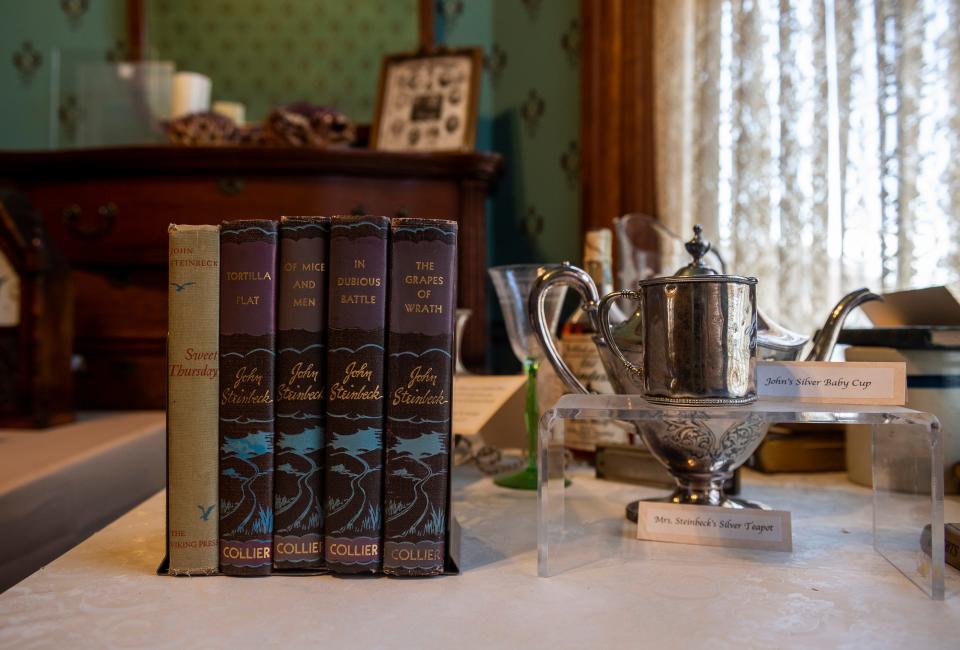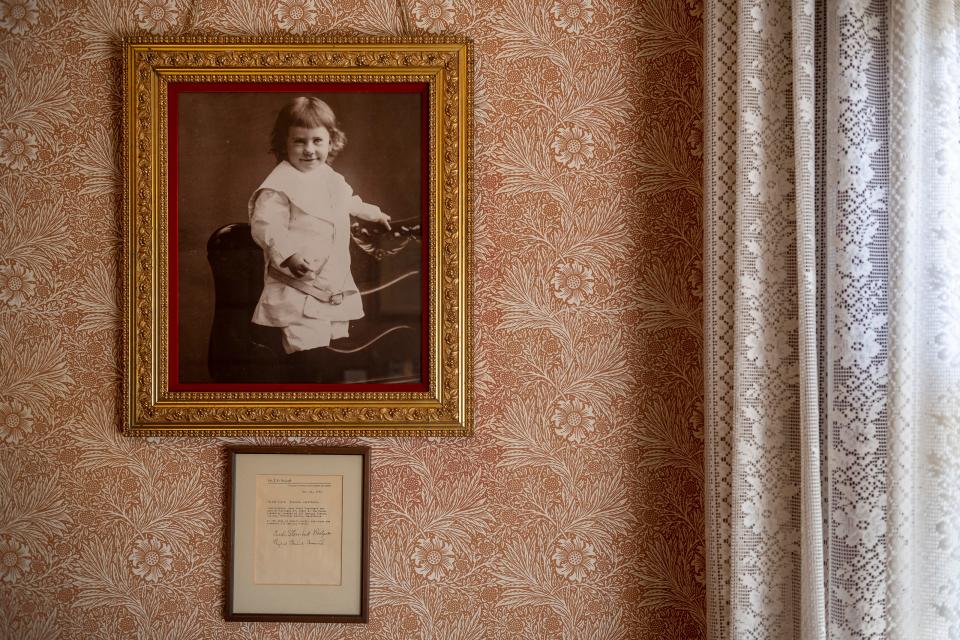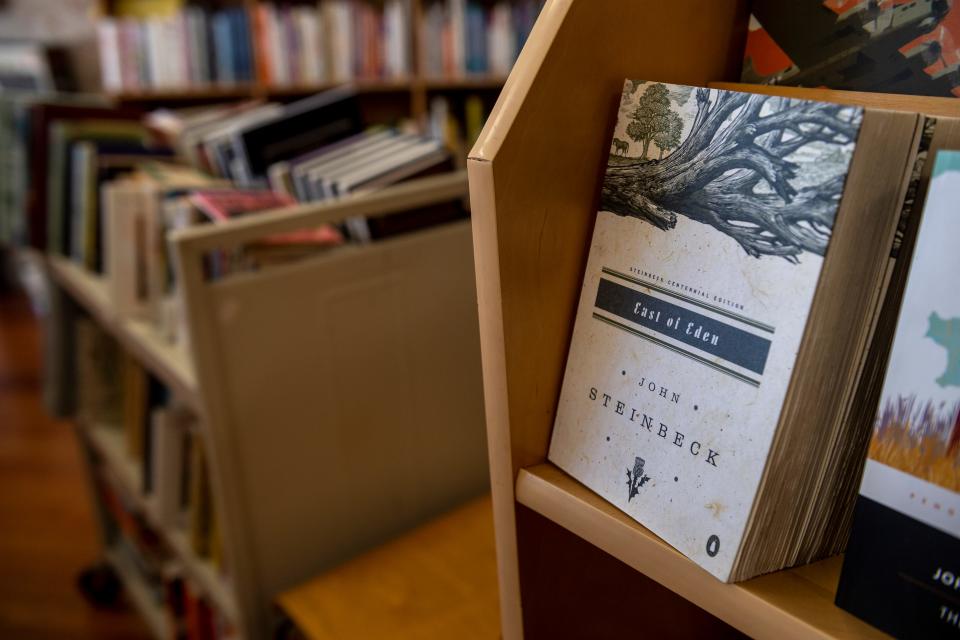Californians have chosen their favorite author of all time
- Oops!Something went wrong.Please try again later.
Californians have chosen Salinas native John Steinbeck as their favorite author of all time, according to a recent poll by StoicQuotes.com.
Steinbeck grew up in Salinas, attended Salinas High School, and used the Salinas area as a setting for many of his novels, including "The Grapes of Wrath."
I sat down with National Steinbeck Center archivist Lisa Josephs, who has been chronicling Steinbeck-specific history since 2015, to hear her thoughts on why Steinbeck still looms large in Salinas and beyond.
This interview has been lightly edited for brevity and clarity.

Q: What kind of work do you do as an archivist here?
A: I'm in charge of the collection that was started by the Salinas Public Library in the mid 60s. So they started a collection of Steinbeck material with a donation of a collection of first editions of Steinbeck's works. And since then, particularly from the '80s and '90s, the library director over there was really big into collecting Steinbeck. And so the city of Salinas, through the library, pulled together this huge collection and it moved over here in 1998 when the center opened, because we have a climate-controlled space here.
I am right now in the middle of cataloguing the collection and I continue to be responsible for new acquisitions. Our biggest acquisition, I think, probably ever, was in 2022. We got the lifetime collection of Ken and Karen Holmes. They've been collecting Steinbeck material for the better part of 60 years and so we got their collection as they wanted to downsize. So I'm cataloging and then I also work to make those things available to people. The catalog is part of that so people can search for it themselves. I do archive showings here. So when our guests come and visit, I show them things from the collection. I also am working with them. And I work with our other local institutions to try and make things available as much as possible or help put on small exhibits here from collection items so we can just, you know, show off what we have and let people know what's here and why it's here.

Q: And what do you think is the most unexpected or unique part of the collection here?
A: We have a wonderful collection of oral histories that was done by librarians from the Salinas Public Library in the mid '70s to mid '80s. And this is a collection of interviews of over 130 people, totaling over 350 hours worth of talking. But there is nothing like it in the world. And this is all people who knew Steinbeck, who were associated with him in some way, who lived across the street from him... anything, any connection you can possibly think of. Or heck, some of the actors and actresses who played in Steinbeck films. In the library, they get interviews with those people and bring them all together into this very, very special collection that I'm pretty sure has been, since its existence, used in every [Steinbeck] biography since then.
And upstairs in the exhibit hall, we have Rocinante, the truck that Steinbeck did his travels with. It's part of the permanent collection upstairs, but it's technically an archive item and, you know, archives rarely have whole trucks. The whole three-quarter ton truck being a part of the collection is a little weird. We're probably one of the few places outside of serious car museums that has an entire truck and camper shell.
Q: That's really cool. Can you tell me about how Steinbeck's memory has been kept alive in Salinas now?
A: Oh, sure. So I like to say that the National Steinbeck Center is doing our part, just by being here. I also think that the Steinbeck house just three blocks away from us is doing a wonderful job, especially reminding people that Steinbeck was a child here. His home is tangible. And there's something special about home, you know, so people come and visit it. It's just beautiful. It has that little something, that little touch of home and comfort. You can kind of imagine the family just sitting in the living room together. They have pictures of that, so they're certainly doing a wonderful job in terms of representing Steinbeck's childhood and youth here in Salinas. We're working with his wider collection and his legacy and all of his works. We try to do this through our various outreach on social media and through our educational programs.
The Steinbeck Young Authors were our middle schoolers reading "The Red Pony" [a novella by Steinbeck]. We also have a yearly festival which is coming up at the end of September, Steinbeck week. That's always a huge part of our year. And we're working very hard to make sure that we have at least three rotating exhibits each year in a small gallery in our permanent exhibit. We just did this thing called John's Jackets, where we looked at the art and history of the book jacket -- what they are as material objects and how they relate to Steinbeck's legacy. And Steinbeck also had some fascinating artists working on his books to represent them through the book jacket. Right now we have (just finished) running Steinbeck Country on Plein Air. The Monterey Bay Plein Air Painters Association are the people who go out and paint in public from the wild world, looking at what they're seeing and painting it directly. So we've been displaying their work and I think it's just a celebration of how gosh darn pretty it is here. Steinbeck noted that thousands of times throughout his works in beautiful descriptions of this area... it's very hard to find something that's not pretty in Monterey County.

Q: Why do you think Steinbeck was chosen as California's favorite author?
A: Ah, I'd like to think it's because he really captures a universality and really speaks to aspects of life that are never changed. So yes, "The Grapes of Wrath" is about the Dust Bowl and the Okie migrants but it's also about dealing with hardship. And everybody has hardship in their lives. Hardship is universal. It doesn't end. I mean, "East of Eden" is about families and the tension within a family and trying to live up to difficult expectations of a father or having a really terrible relationship with one's mother. These are all things that people have. They're just universal. So I like to think it's because he really captured those things. And yes, he set them in time and place and they have a particular moment from roughly the 1930s through the 1960s. That's really where his work is bracketed in time. But we still kind of deal with the same issues. I think that's one of the best parts, and it's also because some of his descriptions are just prose. Poetry. There's a beautiful section in "Sweet Thursday" where he's describing a beautiful day here on the Central Coast, and it's perfect, it is absolutely perfect, and I've had the wonderful experience of having a few of those days. They're rare. They're not every day, but when the weather is right and all the conditions are just perfect, it's there. He says [on these days on the Central Coast] the air is washed and polished like a lens and you can see for miles. I love that. And that's exactly what it is. So I love to think that people also appreciate that celebration of the natural world.
Q: And can you tell me more about how Salinas as a setting was important? To Steinbeck as he grew up here and how that contributed to his work?
A: Oh yeah. We're hoping to actually talk about that in the exhibits. (Salinas) was a beautiful backdrop for Steinbeck to first experience the natural world as a little boy. He was out in the field swamps, drainage dishes, just sticking his nose into toad holes and birdwatching and looking at grasses and flowers and all sorts of things. So he had the perfect place to have that childlike wonder of the natural world. And I think that as a foundation certainly helped his naturalistic writing and his engagement with the environment. I also think that he had a fascinating experience with his own family. His father encouraged that love of the natural world. His father taught all of his children how to garden and keep a beautiful garden. His father was the one who rode a horse regularly through the fields just to really stay in touch with the soil and land.
His mom's family, the Hamiltons, were from Ireland. And so she was telling Irish folk tales, where everything's a little enchanted and everything's a little... a little more magical than it might be, you know -- you look twice and suddenly, it's more magical than it is. So I feel like his family also encouraged that kind of eye for the world. One of his aunts gave him a copy of the King Arthur stories and so he and his little sister would search for the Holy Grail in in around Salinas. They played. They made cardboard armor and swords and did all that really painfully cute, adorable kid stuff. I think a lot of those childhood experiences built that foundation. Here in Salinas, I think he was the right person in the right place with the right outlook.
Q: So what Steinbeck novels do you recommend? Or even short stories? For someone who's unfamiliar with his work or getting into reading it for the first time?
A: That can be a little hard. The thing is, Steinbeck works are so different from one another.
The first thing I would really caution someone to consider is that just because they didn't like one doesn't necessarily mean they won't like another. Some people aren't [aware that] Steinbeck wrote nonfiction. So if you really, really are only into nonfiction and hate narrative and hate fiction, Steinbeck has some nonfiction for you. So "America and Americans and Selected Nonfiction," a collection of Steinbeck's essays from his final published work, "America and Americans," but then also some selected essays from throughout his life, where he's writing about politics, or writing about Salinas and what he thinks of it, or writing about becoming a New Yorker and how he moved to New York... so that's for the nonfiction person. But Steinbeck stories are very wide variety. So I'm just currently right now rereading Steinbeck's short story "The Breakfast", which looms just beautifully atmospheric. It describes this beautiful morning in the valley, where strangers coming along see a camp. And then that's just strangers sitting down and having a nice breakfast together. It's just a very human moment. It's not like anything happens, it's just atmospheric and pretty.
I mean of course there are the classics too, I gotta say "The Grapes of Wrath" and "Of Mice and Men" are obviously two of the most important Steinbeck works. I always make a case for a World War II era work that Steinbeck wrote called The Moon Is Down about people living under occupation. So Steinbeck doesn't say who it is or who the occupiers are, but it's pretty clear that it's Norway living under Nazi occupation. And to me, I love this work because it's an act of empathy. Steinbeck was told later, after World War Two, "how did you know what we were thinking and feeling?" And he said, "Well, I just thought, what would I do in your situation?" And again, he got to that universal point, just by an act of empathy. He did not live under Nazi occupation. He did not go to Norway to understand what people were living through. But he was able to represent it in literature and it was one of the most popular works in Denmark, Sweden and Norway at the time. Maybe there's other standard works that are more artistic, but the empathy is really [evident in] this one. To me, it is a supreme act of empathy. And it was written as propaganda. He was using his art for a political purpose, which was to raise morale for people living under Nazi occupation. So an author like Steinbeck can write a wide variety of works for a wide variety of reasons.
Q: And then, out of all of his works, which do you feel is the most like Salinas specific? Or most related to the local scene here?
A: Definitely "East of Eden". Steinbeck started thinking about "East of Eden" in 1948. But it was a book that was playing in his mind for many years as his [self-proclaimed] "big book". And he writes in a letter that he's writing "East of Eden" for his boys to explain to his sons who he is as a person and where he came from. So "East of Eden" was Steinbeck's attempt to write [directly] to his sons who were around 5 years old at the time. So obviously it's very steeped in Salinas. It's very steeped in that history. And it's very steeped in what he thinks is important. It was finally published in 1952. It also combines all of his memories of childhood and being a child here [in Salinas] with everything that he's learned being a 50-year-old man and having figured out a thing or two about life. No one figures everything out, but it really represents some of the lessons that he's learned over his lifetime and [his attempt] to explain [those lessons] to his boys who will read it many, many, many years later when they can finally understand.
The thing to remember with Steinbeck is that, you know, he's not just Salinas. He's really a fascinating connection with just the middle third of the 20th century in terms of what he was reacting to and thinking about. He's this fascinating connection between this [Salinas] area and national conversations. I think it's very important to remember that you know him as an individual and all of us are part of those national conversations. And so I feel he's a good example to remind ourselves that just one person can have a very interesting connection to things [that goes] so beyond their local area. So, yes, "East of Eden" is set here in Salinas Valley from about 1892 to 1914. But it's also a story about good and evil. This whole concept that religions have dealt with for thousands of years. So I really think it's fascinating to think about Steinbeck as a bridge between the specific and the universal. We can all engage with and move between extremes that you know of day-to-day life which are very specific but also representative of so much more. And I think Steinbeck is a good reminder of that and he invites us through his work to see those connections between here and everywhere else.
Steinback serves as a legendary bridge between Salinas and the greater world -- and vice versa. For more updates, subscribe to The Californian's Daily Briefing newsletter here for a weekly Wednesday "Slice of Steinbeck". 🍕
This article originally appeared on Salinas Californian: Steinbeck as Californians' favorite

